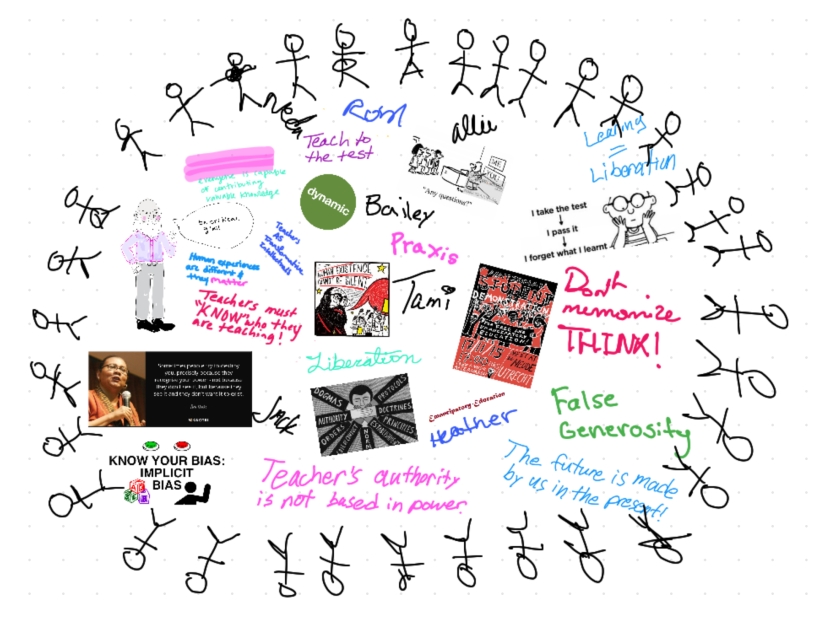This post was a collaborative effort with Jack Viere, Heather Corley, Allie Briggs, Bailey Houghtaling, Tami Amos, and Neda Moayerian
This past week, our class used the Jigsaw Classroom technique to explore the ideas of Paulo Freire and Critical Pedagogy. Through the discussion of our different sources, we identified common themes, topics, and key words. As a table, we define Critical Pedagogy as the following:
Critical Pedagogy first acknowledges power structures in order to reciprocally cultivate knowledge within a dynamic learning space that acknowledges varying human perspectives and life experiences, promotes continual questioning, and liberates marginalized view points.
When looking to consolidate our ideas together, we decided to make a mural, or a shared whiteboard. The featured image above shows the whiteboard as of Wednesday, 3/28. The whiteboard has various phrases, ideas, and themes that we felt were important to the idea of Critical Pedagogy.
While it is creative, it also ties into the idea of Critical Pedagogy as a contrast to the Banking Model of Education. Freire critiques the Banking Model, which views students as nothing more than vessels to accept the knowledge given to them. In view of Critical Pedagogy, both students and teachers have the opportunity to learn. In order to keep with that idea that learning involves both the author and the reader, we invite you to add your own contributions to our whiteboard!

Cool! I really liked the idea of making a whiteboard.
LikeLike
I thought this was a nice representation of critical pedagogy, and a particularly creative idea to use a whiteboard. Giving everyone a space in the same visual is a great way to emphasize the benefit of everyone participating in the learning process. Thanks!
LikeLike
Hopefully that worked, and my wonderful contribution is still there. It is a good representation of critical pedagogy, as we are free to engage with it as we see fit. Pictures, wise sayings, not-so-wise saying, or dank memes are all contributions. Although, I do sense a power structure here. As I had to agree to cookies and other miscellaneous things. Could this be the digital face of the power? Turning over your data in exchange for something.
LikeLike
The whiteboard was such a great idea. I love the images you all used and how everyone was represented.
LikeLike
Awesome use of the whiteboard as a visualization project! I’ve seen a similar concept at William and Mary where Students for a Democratic Society built what they called the free speech grafiti wall. It was Just a series of plywood sheets on posts with racks of spray paint everywhere for people to use.
LikeLike
I love the mural and I love that you included a shared whiteboard in this post! What a great way for us all to contribute!
LikeLike
I really enjoyed this visual representation of critical pedagogical perspectives and diverse inclusiveness. These ideas are not only seen, but felt in a way that makes me as a viewer more engaged with the ideas that they are demonstrating. The vibe of community is also really strong here.
LikeLike
Such a beautiful definition! I think you captured a good representation of Paulo Freire and Bell Hooks present; taking into account different background and experiences, highlighting the notion of questioning and providing space and empowering marginalized groups.
LikeLike
I love the idea of the shared whiteboard! With this idea, everybody can participate and add something more which makes it even more equal and collaborative. Also, your collaborative work looks great and represented the important parts of the critical pedagogy concept very well. Great job!
LikeLike